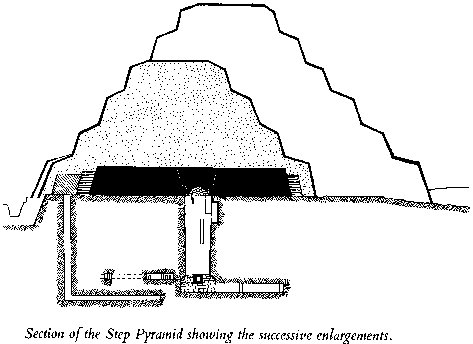|
Djoser
Step Pyramid It is presently accepted that the Step Pyramid of Djoser (AKA Netjerykhet) represents the initial transition from mastaba to pyramid. Indeed, this pyramid actually started out as a mastaba, and was expanded in a series of stages that result in its present appearance which is a pyramid consisting of 6 distinct steps. One of the things that are unique about the Step Pyramid is the arrangement of its internal passageways and chambers. This pyramid has the most complex underground layout, and was one of the very first of its kind. The main excavator that has done the most work on this pyramid and its surrounding structures is Jean-Philippe Lauer. J.P. Lauer can still be seen at Saqqara today, continuing his work with the restoration of the site.
There is a 20 meter tunnel leading northward that would
have extended to outside the tomb during its initial stage as a mastaba. When
the tomb was ended by steps to a pyramid this caused the tunnel to now end
blindly. The burial chamber was surrounded by four galleries which
were cut around the burial chamber and probably contained the funerary equipment
of the king. Some of the galleries were lined with blue faience tiles, and
resembled mats which were hung on the walls of the kings royal residence. Additionally, there were shafts cut into the eastern side
that were over 32 meters deep. These terminate in a corridor 30 meters long
pointed westward toward the original mastaba. All were found during excavations
to be looted with the exception of one that contained two alabaster coffins, one
of which contained the mummy of a child. The stages began with the original mastaba. It is believed that the first enlargement consisted of the addition of 3 meters to all sides of the mastaba. The next enlargement added about 9 meters to the eastern side. After this there was again a 3 meter enlargement on all sides. From this base, they began to create 3 more mastabas, stacked up, each smaller than the one below it. This created the first Step Pyramid. A temple was started on the north side. Before this was finished, or perhaps before the pyramid was cased, another revision was made. The pyramid was enlarged on its north and west sides and two additional steps were added. After this it appears that all sides were enlarged once more for the last time yielded the final dimensions of this great monument. The Pyramid was faced with fine white limestone. In its original condition, it must have been a spectacular sight to behold. The Step Pyramid Complex Rather than only speak of pyramids it is more appropriate to discuss the entire pyramid complex. Pyramids were not built as stand alone structures but were part of a complex that consisted of standardized components. From the 3rd Dynasty on, these remain fairly consistent throughout the Pyramid Age. However in the earlier pyramids we see formative versions of the pyramid complex. We refer to the Step Pyramid of Djoser as the Step Pyramid Complex. This complex existed within an enclosure wall and was elaborate in its design and layout. This pyramid complex is surprisingly intact and allows us to glimpse into the some of the intentions of its builders.
The entire complex is enclosed by a wall which is made of white limestone. The main and most obvious component of this complex is indeed the pyramid. Another important addition is called in modern terms, the South Tomb. Located on the southwestern corner of the complex, this enigmatic component demonstrates three features which are replications of components of the substructure of the pyramid. This includes a descending corridor, a shaft leading to a granite vault, and finally, blue faience-tiled chambers, again emulating the king’s palace. Three false door stelae were found in one chamber, three were also found within the substructure of the pyramid within the galleries. The granite vault in the South tomb is smaller than the one under the pyramid, too small for a human burial. There are many theories as to what was put in this vault. These range from containing the kings viscera, containing a statue of the king, to being a cenotaph or symbolic tomb. In later pyramids we see the development of smaller satellite pyramids. Could it be that this tomb was a precursor to these? There are two distinguishing features of many of the buildings in the complex. One is that these buildings are built as some type of dummy double, or simulacrum, of actual buildings which stood in the royal palace of the king, in Memphis. The original buildings from which these are modeled were made of mudbrick, wood and reeds, and have not survived intact as have these structures. A second feature of note is that many of these features were not seen before or since. These early pyramid complexes have components which are unique to this period. As we move into the subsequent pyramid complexes of the 4th Dynasty we begin to see a new standard with components that remain more or less consistent throughout the pyramid age. Credits for Illustrations Plan of Djoser Pyramid Complex - The Pyramids - Ahmed Fakhry Djoser Step Pyramid Complex -The Complete Pyramids - Mark Lehner Bibliography and Suggested Reading Edwards,
I.E.S. The
Pyramids of Egypt.
New York and London, Penguin Books, 1985 Fakhry, A. The
Pyramids. Chicago and London, 1969 Hawass,
Zahi, The
Pyramids of Ancient Egypt. Pittsburgh. 1990 Lehner, Mark. The
Complete Pyramids.
London. 1997 Lepre, J.P.
The
Egyptian Pyramids.
North Carolina. 1990 Mendelssohn, K. Riddle
of the Pyramids. New York. 1974 Petrie, W. M. F. The
Pyramids and Temples of Gizeh. London. 1883 Siliotti, Alberto. Guide
to the Pyramids of Egypt, Cairo, 1997 Andreu, Guillemette, Egyptian
Art in the Age of the Pyramids. Ithaca and London. 1997
This
is an excerpt from the book, Copyright
© 2000-2005 Andrew Bayuk Return to Guardian's Ancient Egypt Bulletin Board
|

